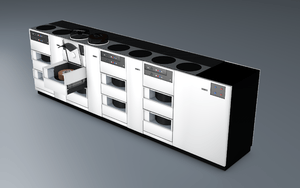IBM System/370 Model 135
 | |
| Manufacturer | International Business Machines Corporation (IBM) |
|---|---|
| Product family | System/370 |
| Release date | March 8, 1971 |
| Discontinued | October 16, 1979 |
| Website | Official website IBM Archives |

"Expanded channel capacity
and the ability to use the high-performance
IBM 3330 disk storage under either Operating System (OS)or Disk Operating System (DOS) were ... among the factors significant to the Model 135}'s ...capabilities."
The IBM System/370 Model 135 was announced March 8, 1971,[1] the only 370 introduced that year. The 135 was IBM's fifth System 370,[2] and it was withdrawn October 16, 1979.
Special features
Although microcode was not a uniquely new feature at the time of the 135's introduction, the ability to upgrade a system's microcode without changing hardware was not common at that time.[3][4] "Later models like the 85 and 25 had writable control stores, the 85 using a volatile SRAM array and the 25 using a part of core memory."[4]
A "reading device located in the Model 135 console" allowed updates and adding features to the Model 135's microcode.[1][5] [6] The 145, introduced the prior year, also had this feature.[7]
Optional features
The Model 135 was the last of the 370s to be introduced without Virtual memory. Four of the five[8] could be upgraded. Unlike the 155 & 165, which required an expensive [9] hardware upgrade to add a DAT box (Dynamic Address Translation), the 135 & 145 [10] could get obtain their virtual memory upgrade from a floppy disk.
Microcode upgrades were also available to add "user-selected options such as
- extended precision arithmetic or
- emulation of the IBM 1400 series."[1][11]
An upgraded Model 135[12] was termed a 370/135-3[13]
Customers of the 370/135 had a choice of four main memory sizes, ranging from 96K to 256K.
Other
- The 370/135 was introduced as running "under either OS or DOS.[1] Newer versions thereof (DOS/VS and OS/VS1) and Virtual Machine Facility/370 (VM/370) subsequently became available options once the 135's microcode was upgraded to support virtual memory. This was priced at $120,000 and came with "increased reloadable control store in addition to some power units." The upgrade could be done "in the field" and the resultant system was now deemed a 370/135-3.[14]
- The 135 was "partly developed at Hursley, UK."[15]
External links
Images
See also
References
- 1 2 3 4 "System/370 Model 135". IBM Archives. IBM.
- ↑ of 11
- ↑ A. Padegs (September 1981). "System/360 and Beyond". IBM Journal of Research & Development. IBM. 25 (5): 377–390. doi:10.1147/rd.255.0377. – tables include model characteristics (Table 1) and announcement/shipment dates (Table 2). The S/370-155-II and -165-II are listed under the former but not the latter, because the upgraded systems were not formally announced as separate models. The "System/370 Advanced Function" announcement, including the -158 and -168, was the main public event.
- 1 2 https://groups.google.com/d/topic/alt.folklore.computers/RZA6FD27Tc0 QUOTE: control store was Card Capacitive ROS. System/360's used a variety of read only control stores, so changing the microcode meant replacing parts (e.g., with parts that were personalized by punching holes in a card).
- ↑ The "reading device" was a built-in (read-only) floppy disk drive.
- ↑ http://www.computerhistory.org/revolution/memory-storage/8/261
- ↑ http://www.computerhistory.org/timeline/1968/#169ebbe2ad45559efbc6eb357200edaf describes it as an 80K 8-inch floppy.
- ↑ the 135, 145, 155 and 165, but not the 195
- ↑ $200,000 and $400,000 respectively
- ↑ http://www.bitsavers.org/pdf/ibm/370/fe/3145/SY24-3581-1_3145_Processing_Unit_Theory-Maintenance_Oct71.pdf IBM Maintenance Library 3145 Processing Unit Theory - Maintenance (Third ed.). IBM. pp. CPU 117–129. SY24-3581-2.
- ↑ (1401, 1440 and 1460)
- ↑ https://books.google.com/books?id=pGJK0ayV3S8C&pg=PT1&lpg=PT1 Computerworld,July 5, 1976,p.2
- ↑ and the upgrade could be done "in the field."
- ↑ "Users May Have Jump on Upgrades". Computerworld. July 5, 1976. p. 2.
- ↑ "Some Key Dates in IBM's Operations in Europe, the Middle East, Asia" (PDF). IBM.